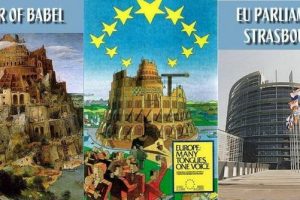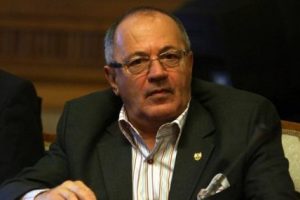 The IMF is trying to move the world away from the U.S. dollar and towards a global currency once again. In a new report entitled “Enhancing International Monetary Stability—A Role for the SDR”, the IMF details the “problems” with having the U.S. dollar as the reserve currency of the globe and the IMF discusses the potential for a larger role for SDRs (Special Drawing Rights). But the IMF certainly does not view SDRs as the “final solution” to global currency problems. Rather, the IMF considers SDRs to be a transitional phase between what we have now and a new world currency. In this newly published report, the IMF makes this point very clearly: “In the even longer run, if there were political willingness to do so, these securities could constitute an embryo of global currency.” Yes, you read that correctly. The SDR is supposed to be “an embryo” from which a global currency will one day develop. So what about the U.S. dollar and other national currencies? Well, they would just end up fading away.
The IMF is trying to move the world away from the U.S. dollar and towards a global currency once again. In a new report entitled “Enhancing International Monetary Stability—A Role for the SDR”, the IMF details the “problems” with having the U.S. dollar as the reserve currency of the globe and the IMF discusses the potential for a larger role for SDRs (Special Drawing Rights). But the IMF certainly does not view SDRs as the “final solution” to global currency problems. Rather, the IMF considers SDRs to be a transitional phase between what we have now and a new world currency. In this newly published report, the IMF makes this point very clearly: “In the even longer run, if there were political willingness to do so, these securities could constitute an embryo of global currency.” Yes, you read that correctly. The SDR is supposed to be “an embryo” from which a global currency will one day develop. So what about the U.S. dollar and other national currencies? Well, they would just end up fading away.
CNN clearly understands what the IMF is trying to accomplish with this new report. The following is how CNN’s recent story about the new IMF report begins….
“The International Monetary Fund issued a report Thursday on a possible replacement for the dollar as the world’s reserve currency.”
That is exactly what the IMF intends to do.
They intend to have SDRs replace the U.S. dollar as the world reserve currency.
So exactly what are SDRs?
Well, “SDR” is short for Special Drawing Rights. It is a synthetic currency unit that is made up of a basket of currencies. SDRs have actually been around for many years, but now they are being heavily promoted as an alternative to the dollar.
The following is how Wikipedia defines SDRs….
Special Drawing Rights (SDRs) are international foreign exchange reserve assets. Allocated to nations by the International Monetary Fund (IMF), a SDR represents a claim to foreign currencies for which it may be exchanged in times of need.
The SDR is a hybrid. SDRs are part U.S. dollar, part euro, part yen and part British pound. In particular, the following is how each SDR currently breaks down….
U.S. Dollar: 41.9%
Euro: 37.4%
Yen: 9.4%
British Pound: 11.3%
Now there are calls for other national currencies to be included in the basket.
Russian President Dmitry Medvedev has publicly called for the national currencies of Brazil, Russia, India and China to be included in the SDR.
In January, the Obama administration said that it fully supports the eventual inclusion of the yuan in the SDR.
So yes, it looks like we are definitely moving in the direction of the SDR becoming a true global currency.
But is this a good idea?
Globalist organizations such as the IMF say that having a true global currency would facilitate world trade, it would make currency wars less likely, it would stabilize the global economy and it would make the rest of the globe less reliant on what is going on in the United States.
In fact, there is a lot of discussion in international financial circles that oil should be traded in SDRs rather than in U.S. dollars.
In a recent interview, IMF Deputy Managing Director Naoyuki Shinohara even suggested that the IMF may actually consider issuing bonds that are denominated in SDRs. Apparently the goal would be to promote the use of the new “currency”.
But once again, it is important to remember that the IMF does not see SDRs lasting forever either. Rather, the IMF considers the SDR to be an “embryo” from which a true global currency could emerge.
An IMF paper entitled “Reserve Accumulation and International Monetary Stability” that was published last year even proposed that a future global currency be called the “Bancor” and that a future global central bank could be put in charge of issuing it….
“A global currency, bancor, issued by a global central bank (see Supplement 1, section V) would be designed as a stable store of value that is not tied exclusively to the conditions of any particular economy. As trade and finance continue to grow rapidly and global integration increases, the importance of this broader perspective is expected to continue growing.”
In fact, at one point the IMF report from last year specifically compares the proposed global central bank to the Federal Reserve….
“The global central bank could serve as a lender of last resort, providing needed systemic liquidity in the event of adverse shocks and more automatically than at present. Such liquidity was provided in the most recent crisis mainly by the U.S. Federal Reserve, which however may not always provide such liquidity.”
Yes, unfortunately this is what the IMF really has in mind for all of us. A one-world economic system with a one-world currency and a one-world central bank.
Is that what we really need?
A “global Federal Reserve” that dominates the currency and the economy of the entire planet?
A “global Federal Reserve” would not answer to anyone. Individual nations could attempt to pull out, but then they would potentially be isolated from the rest of the globe and potentially cut off from world trade.
That may sound very far-fetched now, but that is the direction we are headed.
And shifting away from the U.S. dollar as the reserve currency of the world would be disastrous for the U.S. economy.
Right now the fact that the U.S. dollar is the primary reserve currency of the world is one of the only things holding it up. If you took that support away the U.S. dollar could end up collapsing quite quickly.
Let us hope that the people wake up and start insisting that we want no part in a global currency. If we ever allow a world currency(…), we will lose a great deal of our economic sovereignty. Not that we haven’t lost most of it already, but at least if we are still using our own national currency there is a greater chance that we can reclaim it.
What the IMF is proposing right now may seem very innocent, but the long-term consequences of going down the road they want to put us on could potentially be absolutely catastrophic.
The people need to send a very clear message to their representatives:
#1 We do not want a one-world economy.
#2 We do not want a one-world currency.
#3 We do not want a one-world central bank.
source: theeconomiccollapseblog.com












Adauga comentariu